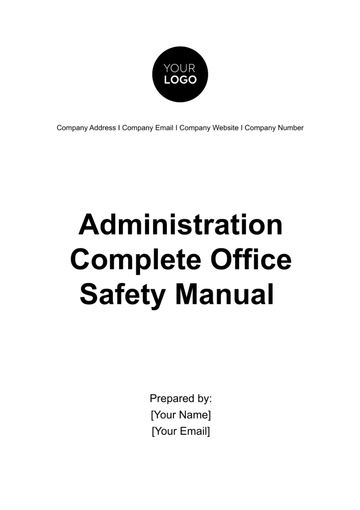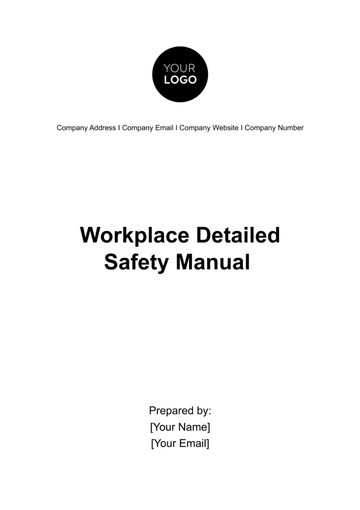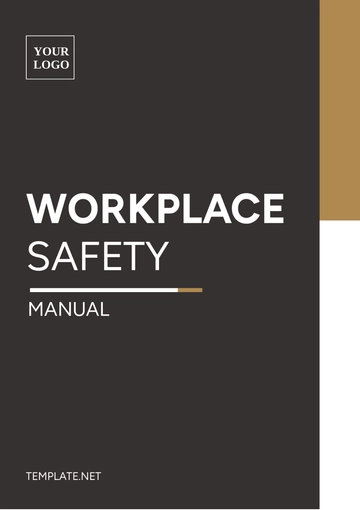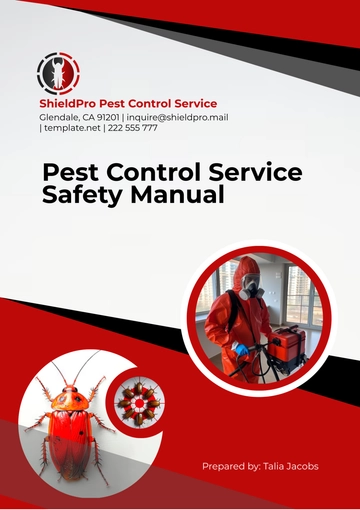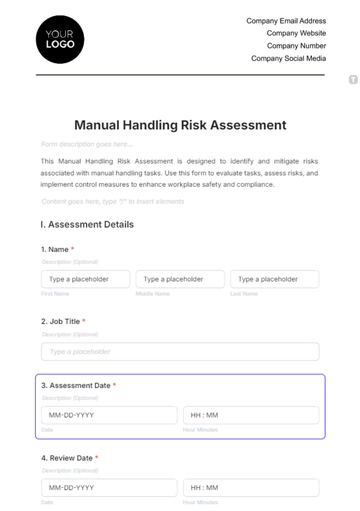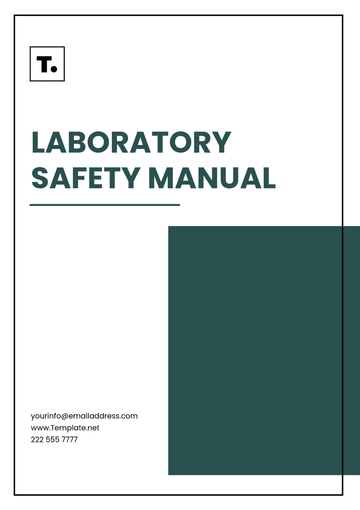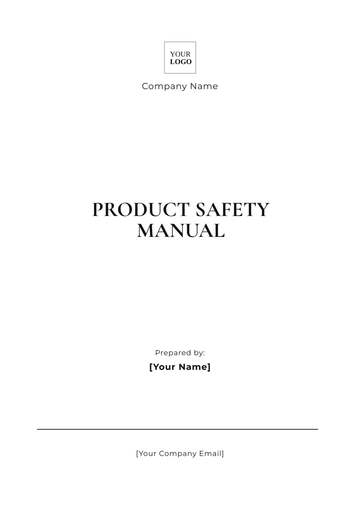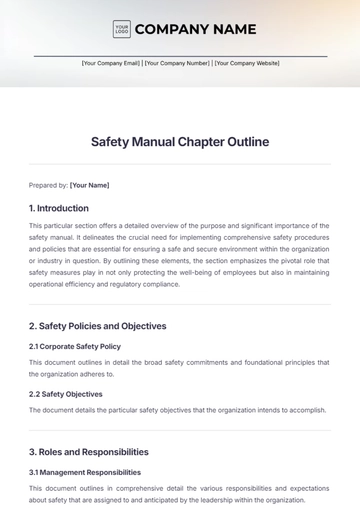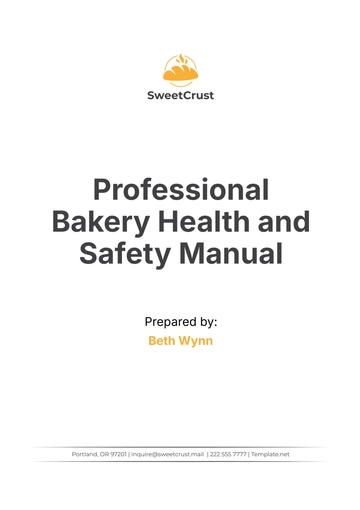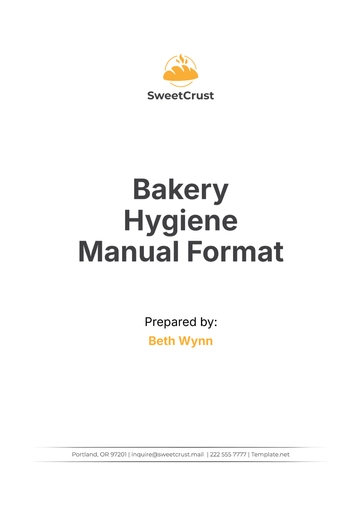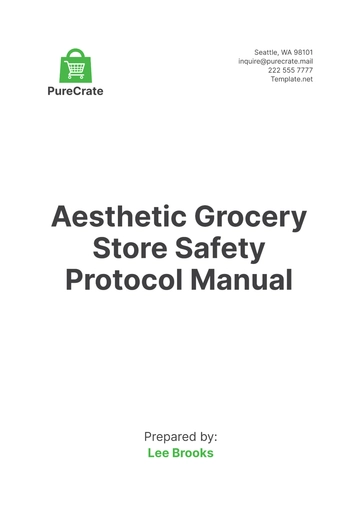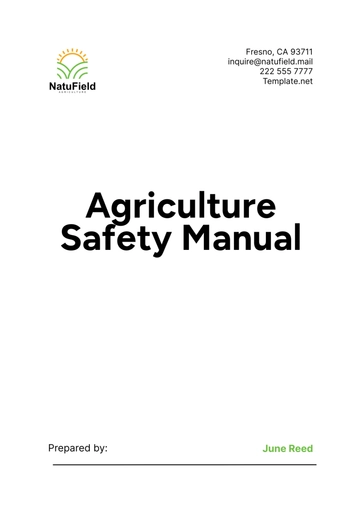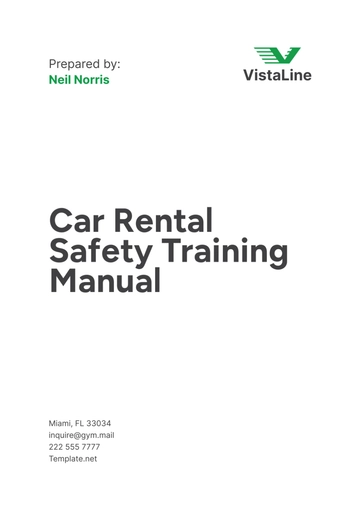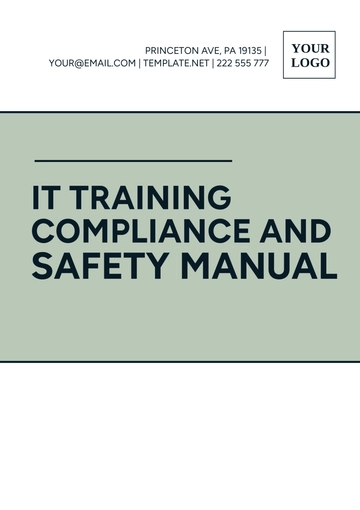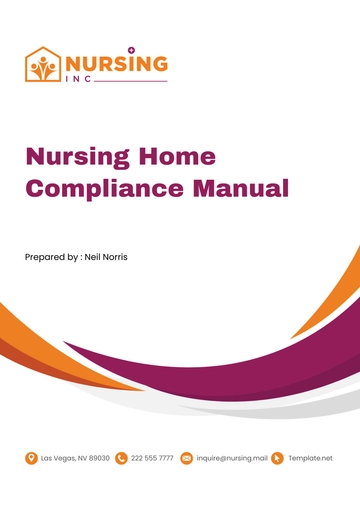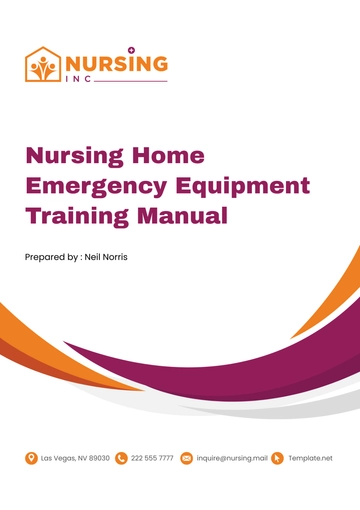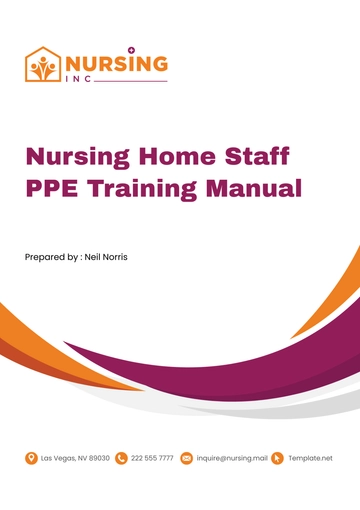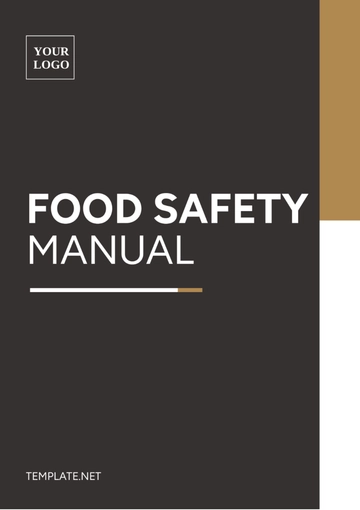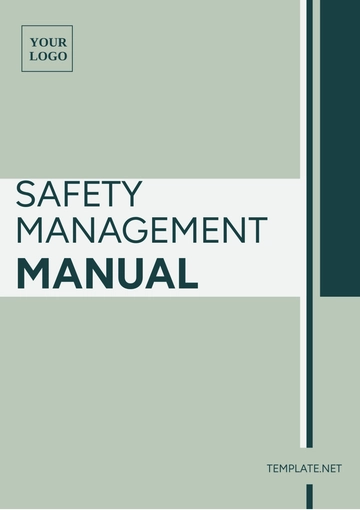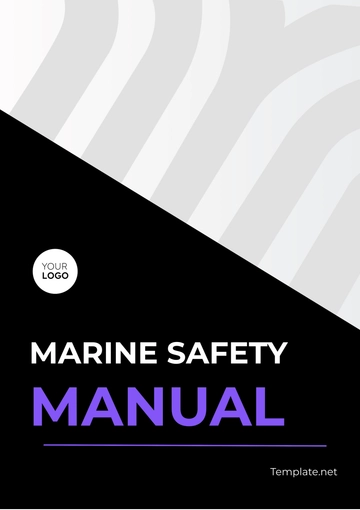Free Agriculture Safety Manual
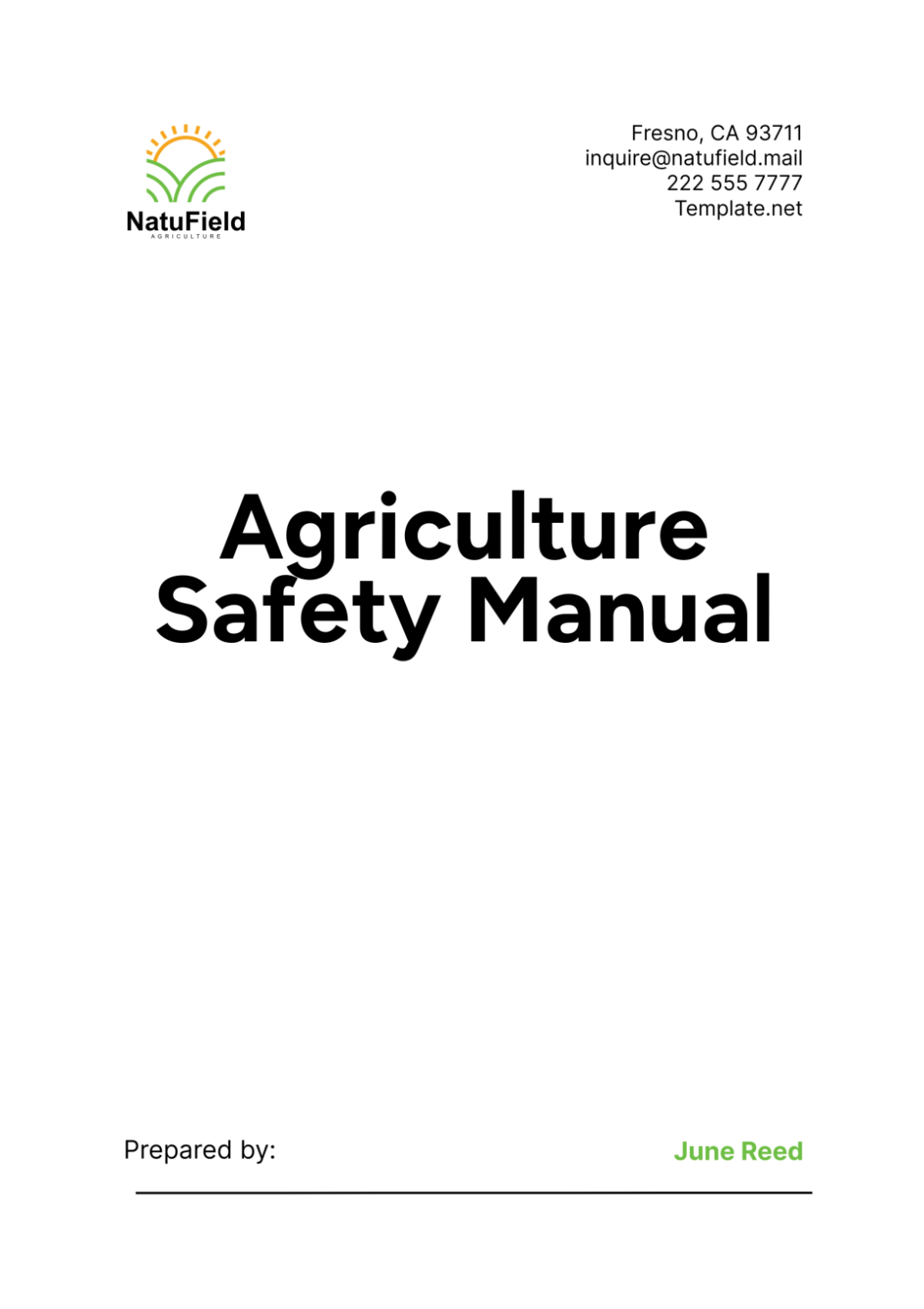
I. Introduction
A. Purpose
The purpose of this Agriculture Safety Manual is to establish guidelines and procedures that ensure a safe and healthy work environment for all employees of [Your Company Name]. The manual aims to identify potential hazards in agricultural operations and provide measures to mitigate risks, ensuring compliance with relevant safety regulations. By adhering to these guidelines, [Your Company Name] strives to prevent accidents and injuries, promoting the well-being of its workforce and fostering a culture of safety.
B. Scope
This manual applies to all employees, contractors, and visitors involved in agricultural activities at [Your Company Name]. It covers safety protocols for various operations, including crop production, livestock handling, machinery use, chemical handling, and emergency procedures. The manual is a comprehensive resource, designed to be used in conjunction with specific training programs and regulatory requirements. It is essential for everyone on the premises to understand and follow the outlined safety practices to maintain a secure work environment.
C. Definitions
Personal Protective Equipment (PPE): Equipment worn to minimize exposure to workplace hazards that can cause injuries and illnesses.
Hazard: A potential source of harm or adverse health effect on a person or persons.
Lockout/Tagout (LOTO): A safety procedure used to ensure that machinery is properly shut off and not able to be started up again prior to the completion of maintenance or repair work.
Safety Data Sheets (SDS): Documents that provide information on the properties of hazardous chemicals and how they affect health and safety in the workplace.
II. General Safety Policies
A. Safety Commitment
Management Commitment:
[Your Company Name] is committed to maintaining a safe and healthy workplace. The management recognizes the importance of safety and is dedicated to providing the necessary resources, training, and support to ensure the safety of all employees. Management will regularly review and update safety policies and procedures to comply with the latest regulations and industry standards.
Employee Responsibility:
Every employee at [Your Company Name] has a responsibility to adhere to the safety policies and procedures outlined in this manual. Employees are expected to actively participate in safety training programs, use the provided PPE, report any unsafe conditions, and take proactive steps to prevent accidents. Safety is a collective effort, and each individual’s commitment is crucial to the overall success of the safety program.
B. Safety Training
Training Programs:
[Your Company Name] provides comprehensive safety training programs tailored to the specific needs of agricultural operations. These programs cover a wide range of topics, including hazard identification, proper use of PPE, machinery safety, chemical handling, and emergency response. Training is delivered through a combination of classroom instruction, hands-on practice, and periodic refreshers to ensure knowledge retention.
Training Schedule
Training sessions are scheduled regularly and are mandatory for all employees. New hires receive initial safety training during their orientation, while existing employees participate in annual refresher courses. Additional training sessions are conducted as needed, especially when introducing new equipment or procedures. The training schedule is communicated in advance to ensure maximum participation.
Training Topic | Frequency | Audience |
|---|---|---|
Initial Safety Training | Upon Hiring | New Employees |
Annual Refresher Courses | Annually | All Employees |
Equipment-Specific Training | As Needed | Relevant Employees |
Emergency Response | Bi-Annually | All Employees |
Training Documentation:
Accurate records of all safety training sessions are maintained by [Your Company Name]. These records include the date of training, topics covered, names of participants, and the trainer’s credentials. Documentation serves as evidence of compliance with safety regulations and helps identify areas for improvement in the training programs. Employees are required to sign attendance sheets to confirm their participation.
C. Personal Protective Equipment (PPE)
Types of PPE: Various types of PPE are used in agricultural operations to protect employees from hazards. This includes helmets, gloves, eye protection, ear protection, respirators, and protective clothing. The selection of PPE is based on the specific tasks being performed and the associated risks.
Proper Use of PPE: Employees are trained on the correct use and limitations of each type of PPE. This includes instructions on how to wear, adjust, and remove PPE, as well as understanding when and where each type should be used. Proper usage is critical to ensuring the effectiveness of PPE in preventing injuries.
Maintenance of PPE: Regular inspection and maintenance of PPE are essential to ensure its reliability. Employees are responsible for keeping their PPE clean and in good condition. Any damaged or worn-out equipment must be reported and replaced immediately. [Your Company Name] provides guidelines for the care and maintenance of PPE to prolong its lifespan and ensure continued protection.
III. Workplace Hazards
A. Hazard Identification
Common Agricultural Hazards: Agricultural operations present a variety of hazards, including exposure to chemicals, machinery-related injuries, animal bites, and biological hazards. Identifying these hazards is the first step in implementing effective control measures. [Your Company Name] conducts regular hazard assessments to identify and evaluate potential risks.
Hazard Assessment: Hazard assessments are performed through workplace inspections, job safety analyses, and employee feedback. These assessments help in pinpointing specific areas of concern and developing strategies to mitigate risks. The findings from hazard assessments are documented and used to update safety protocols.
B. Chemical Safety
Safe Handling of Chemicals: Proper handling of chemicals is critical to preventing accidents and injuries. Employees are trained in the safe use, storage, and disposal of chemicals. This includes understanding the information provided in Safety Data Sheets (SDS) and following label instructions. Personal protective equipment (PPE) must be worn as required when handling chemicals.
Storage of Chemicals: Chemicals must be stored in designated areas that are well-ventilated, secure, and away from incompatible substances. Storage areas are clearly labeled, and containers are kept closed when not in use. Regular inspections are conducted to ensure that storage conditions meet safety standards.
Emergency Procedures: In the event of a chemical spill or exposure, emergency procedures must be followed to minimize harm. Employees are trained to respond quickly and effectively, including the use of spill kits, evacuation procedures, and seeking medical attention if necessary. Emergency contact numbers and procedures are posted prominently in all areas where chemicals are used.
C. Machinery and Equipment Safety
Safe Operation Procedures: Machinery and equipment are essential to agricultural operations but pose significant risks if not used properly. Safe operation procedures are established for each type of machinery, detailing the correct use, potential hazards, and safety precautions. Only trained and authorized personnel are permitted to operate machinery.
Maintenance and Inspections: Regular maintenance and inspections are conducted to ensure that machinery and equipment are in good working condition. Preventive maintenance schedules are followed to identify and address potential issues before they cause accidents. Inspection checklists are used to document the condition of equipment and any corrective actions taken.
Lockout/Tagout Procedures: Lockout/Tagout (LOTO) procedures are implemented to ensure that machinery is properly shut off and cannot be restarted during maintenance or repair work. This involves isolating the energy source, applying locks and tags, and verifying that the machinery is in a zero-energy state. Only authorized personnel can perform LOTO procedures.
D. Biological Hazards
Exposure to Pathogens: Agricultural workers may be exposed to various biological hazards, including bacteria, viruses, and fungi. Proper hygiene practices, such as handwashing and the use of PPE, are critical in preventing infections. Vaccinations may also be recommended for certain diseases prevalent in agricultural settings.
Handling of Livestock: Livestock handling poses risks of bites, kicks, and transmission of zoonotic diseases. Employees are trained in safe handling techniques, such as using appropriate restraining devices and understanding animal behavior. Protective clothing and equipment are worn to minimize exposure to hazards.
Pest Control: Effective pest control measures are essential to maintaining a safe agricultural environment. Integrated pest management strategies are used to minimize the use of chemical pesticides, relying instead on biological control, habitat manipulation, and other non-chemical methods. Employees are trained in safe pest control practices and the proper use of pesticides when necessary.
IV. Emergency Procedures
A. Emergency Action Plan
Roles and Responsibilities: An Emergency Action Plan (EAP) outlines the roles and responsibilities of employees during an emergency. Key personnel are designated to lead evacuation efforts, provide first aid, and communicate with emergency services. Regular drills are conducted to ensure that everyone understands their role and can respond effectively in an emergency.
Emergency Contacts: A list of emergency contacts, including local fire departments, medical facilities, and poison control centers, is maintained and posted in prominent locations. Employees are instructed to contact these numbers immediately in the event of an emergency. Communication protocols are established to ensure timely and accurate information dissemination during emergencies.
B. First Aid Procedures
Basic First Aid: Basic first aid training is provided to all employees, covering essential skills such as treating cuts, burns, and fractures. First aid kits are strategically placed throughout the workplace and are regularly inspected and restocked. Employees are encouraged to seek professional medical attention for serious injuries.
Location of First Aid Kits: First aid kits are located in easily accessible areas, such as break rooms, field stations, and near high-risk areas. Maps indicating the locations of first aid kits are posted throughout the workplace. Employees are trained on the contents of the kits and their proper use.
Reporting Injuries: All injuries, no matter how minor, must be reported to a supervisor immediately. Incident report forms are completed to document the circumstances of the injury, the treatment provided, and any follow-up actions required. This information is used to identify trends and implement preventive measures.
C. Fire Safety
Fire Prevention Measures: Fire prevention measures are implemented to minimize the risk of fires in agricultural operations. This includes proper storage of flammable materials, regular maintenance of electrical systems, and safe use of heating equipment. Employees are trained in fire prevention techniques and the proper use of fire extinguishers.
Use of Fire Extinguishers: Fire extinguishers are strategically placed throughout the workplace and are regularly inspected and maintained. Employees are trained on the types of fire extinguishers available and their proper use. Fire extinguisher training includes the PASS method (Pull, Aim, Squeeze, Sweep) to ensure effective response during a fire.
Evacuation Procedures: Evacuation procedures are established and practiced regularly through drills. Evacuation routes are clearly marked, and assembly points are designated for employees to gather safely. Employees are instructed to remain calm, follow evacuation routes, and assist others during an evacuation. Evacuation drills are evaluated to identify areas for improvement.
V. Specific Safety Guidelines
A. Crop Production Safety
Field Work Safety: Field work involves various tasks such as planting, weeding, and harvesting, each with its own set of hazards. Employees are trained to use tools and equipment safely, follow proper lifting techniques, and stay hydrated to prevent heat-related illnesses. Supervisors monitor field conditions and implement safety measures to protect workers from environmental hazards such as extreme weather and exposure to harmful plants.
Harvesting Safety: Harvesting operations require careful coordination and adherence to safety protocols. Employees are trained to operate harvesting machinery, such as combines and balers, safely. Protective clothing, such as gloves and long sleeves, is worn to prevent injuries from sharp objects and rough surfaces. Safety barriers and warning signs are used to keep unauthorized personnel away from active harvesting areas.
Pesticide Application Safety: Pesticide application poses significant health risks if not done correctly. Employees are trained in the safe handling, mixing, and application of pesticides. This includes wearing appropriate PPE, following label instructions, and using proper equipment. Spraying is done in favorable weather conditions to prevent drift and minimize exposure to non-target areas. Employees are also trained to recognize and respond to symptoms of pesticide exposure.
B. Livestock Handling Safety
Animal Restraint Techniques: Proper animal restraint techniques are essential to prevent injuries to both animals and handlers. Employees are trained in the use of equipment such as halters, chutes, and head gates. Understanding animal behavior and maintaining a calm demeanor helps reduce stress and prevent accidents. Regular inspections of restraint equipment ensure that it is in good working condition.
Safe Feeding Practices: Feeding livestock involves potential risks such as bites and kicks. Employees are trained to feed animals safely, using appropriate tools and maintaining a safe distance. Proper storage and handling of feed are also emphasized to prevent contamination and spoilage. Feeding schedules are established to ensure animals receive consistent and adequate nutrition.
Disease Prevention: Disease prevention is crucial in maintaining a healthy livestock population. Employees are trained in biosecurity measures such as quarantine protocols, vaccination schedules, and proper sanitation practices. Regular health checks and prompt reporting of sick animals help in early detection and control of diseases. Preventive measures are taken to minimize the spread of zoonotic diseases to humans.
C. Farm Vehicle Safety
Tractor Safety: Tractors are commonly used in agricultural operations but pose significant risks if not operated safely. Employees are trained in the safe operation of tractors, including starting, driving, and stopping procedures. Regular maintenance checks are performed to ensure tractors are in good working condition. Safety features such as rollover protection structures (ROPS) and seat belts are used to protect operators.
ATV and UTV Safety: All-terrain vehicles (ATVs) and utility task vehicles (UTVs) are used for various tasks on the farm. Employees are trained in safe driving practices, including the use of helmets and other protective gear. Speed limits and designated riding areas are established to prevent accidents. Regular maintenance and inspections ensure that ATVs and UTVs are safe to operate.
Roadway Safety: Agricultural vehicles often need to travel on public roads, posing additional risks. Employees are trained to follow traffic regulations and use proper signaling when operating vehicles on roads. Reflective markings and warning signs are used to enhance visibility. Safety measures are implemented to protect both operators and other road users.
VI. Chemical Safety
A. Handling and Storage of Chemicals
The handling and storage of chemicals in agricultural operations are critical for ensuring the safety of employees and the environment. Proper procedures must be followed to minimize risks associated with chemical use.
Safe Handling Procedures: Employees must wear appropriate personal protective equipment (PPE) such as gloves, goggles, and aprons when handling chemicals. Chemicals should be transferred using tools designed to minimize spills and exposure. Training on the correct handling techniques ensures that employees are aware of potential hazards and how to mitigate them.
Proper Storage Techniques: Chemicals must be stored in a designated area that is secure, well-ventilated, and clearly labeled. Flammable chemicals should be stored in fire-resistant cabinets, while incompatible chemicals should be kept separate to prevent dangerous reactions. Regular inspections of storage areas are necessary to identify and address any safety concerns.
Chemical Type | Storage Requirements | PPE Required |
|---|---|---|
Pesticides | Locked, ventilated, labeled cabinets | Gloves, goggles, aprons |
Flammable liquids | Fire-resistant cabinets | Fire-resistant gloves |
Corrosive substances | Separate from flammables, ventilated | Full-face shields, gloves |
Emergency Procedures: In the event of a chemical spill or exposure, employees must follow established emergency procedures. This includes immediate notification of supervisors, evacuation of the affected area, and use of emergency showers and eyewash stations. Emergency procedures are posted in visible locations, and drills are conducted regularly to ensure readiness.
B. Pesticide Use and Safety
Pesticides are commonly used in agriculture to control pests and diseases. However, improper use can lead to serious health risks and environmental damage.
Application Guidelines: Pesticides should be applied according to the manufacturer's instructions and regulatory guidelines. This includes using the recommended concentration, application method, and timing. Employees must be trained on how to properly mix and apply pesticides to avoid overexposure and environmental contamination.
Personal Protective Equipment (PPE): When applying pesticides, employees must wear the appropriate PPE to protect themselves from exposure. This includes long-sleeved clothing, gloves, respirators, and eye protection. PPE must be inspected regularly and replaced as needed to ensure its effectiveness.
Post-Application Safety: After applying pesticides, equipment should be cleaned and stored properly to prevent contamination. Employees must wash their hands and any exposed skin thoroughly with soap and water. Re-entry intervals (REIs) must be observed to ensure that employees do not enter treated areas until it is safe.
C. Fertilizer Safety
Fertilizers are essential for crop growth, but they can pose risks if not handled correctly.
Types of Fertilizers: Fertilizers can be classified into various types, each with specific handling and application requirements. Employees must be familiar with the types of fertilizers used in their operations and the associated safety protocols.
Fertilizer Type | Application Method | Safety Precautions |
|---|---|---|
Nitrogen-based | Spreading, injection | Use gloves, avoid inhalation |
Phosphorus-based | Soil incorporation | Avoid skin contact |
Potassium-based | Spraying, broadcasting | Wear eye protection, gloves |
Safe Storage and Handling: Fertilizers should be stored in a cool, dry place away from incompatible substances. Bags and containers should be sealed to prevent moisture absorption and contamination. Employees must use appropriate tools to handle fertilizers and avoid direct contact.
Environmental Considerations: Careful application of fertilizers is necessary to prevent runoff and leaching, which can contaminate water sources. Buffer zones around water bodies should be established, and employees should be trained on the environmental impact of fertilizer use.
VII. Equipment Safety
A. Maintenance and Inspections
Regular maintenance and inspections of equipment are crucial for safe and efficient agricultural operations.
Routine Maintenance: Equipment must be maintained according to the manufacturer's recommendations. This includes regular lubrication, replacement of worn parts, and calibration of controls. Maintenance schedules should be documented, and maintenance tasks should be assigned to qualified personnel.
Pre-Use Inspections: Before using any equipment, employees should conduct a thorough inspection to ensure it is in good working condition. This includes checking for signs of wear and tear, ensuring safety guards are in place, and verifying that controls are functioning properly. Any defects should be reported and addressed immediately.
Record Keeping: Detailed records of maintenance and inspections should be kept to track the condition of equipment and ensure compliance with safety standards. These records help identify patterns of wear and potential areas for improvement in maintenance practices.
Equipment | Inspection Frequency | Maintenance Tasks |
|---|---|---|
Tractors | Daily | Check fluids, inspect tires, test brakes |
Harvesters | Weekly | Sharpen blades, clean filters |
Irrigation systems | Monthly | Inspect pipes, test pumps, clean nozzles |
B. Safe Operation of Machinery
Operating machinery safely is essential to prevent accidents and injuries.
Operator Training: Employees must receive comprehensive training on the safe operation of machinery. This includes understanding the controls, operating procedures, and emergency shut-off mechanisms. Training should be documented and refreshed regularly to ensure ongoing competency.
Use of Safety Features: The machinery is equipped with various safety features such as guards, sensors, and emergency stops. Employees must be familiar with these features and ensure they are not bypassed or disabled. Regular testing of safety features ensures they are functioning correctly.
Operational Guidelines: Safe operating procedures must be followed at all times. This includes maintaining a safe distance from moving parts, using proper lifting techniques, and avoiding distractions while operating machinery. Supervisors should monitor operations and provide guidance as needed.
C. Tool Safety
Hand tools and power tools are commonly used in agricultural operations and must be handled with care.
Selection and Use of Tools: The right tool should be selected for each task to ensure efficiency and safety. Employees must be trained on the correct use of tools, including proper grip, handling, and storage. Tools should never be used for purposes other than their intended use.
Tool Maintenance: Tools should be regularly inspected and maintained to ensure they are in good condition. This includes sharpening blades, tightening loose parts, and cleaning tools after use. Damaged tools should be repaired or replaced promptly.
Storage and Handling: Tools should be stored in a designated area that is organized and secure. Employees must follow proper lifting techniques to prevent injuries when handling heavy tools. Tool storage areas should be kept clean and free of hazards.
VIII. Emergency Procedures
A. First Aid and Medical Emergencies
Proper first aid and medical emergency procedures are vital to ensuring prompt and effective response to injuries and illnesses.
First Aid Training: Employees should receive training in basic first aid, including CPR and the use of automated external defibrillators (AEDs). Training should be refreshed regularly to maintain competency. First aid kits should be readily available and stocked with necessary supplies.
Emergency Contact Information: Emergency contact information should be posted in visible locations throughout the workplace. This includes contact numbers for medical services, fire departments, and supervisors. Employees must know how to quickly access this information in an emergency.
Incident Reporting: All medical emergencies and injuries should be reported immediately to supervisors. Incident report forms should be completed to document the circumstances of the injury, the treatment provided, and any follow-up actions required. This information is used to identify trends and implement preventive measures.
Emergency | Contact Number | Procedure |
|---|---|---|
Medical emergency | Provide first aid, call for medical help | |
Fire | Evacuate, use fire extinguisher if safe | |
Chemical spill | Evacuate, follow spill response procedures |
B. Fire Safety
Fire safety measures are essential to protect employees and property from the dangers of fire.
Fire Prevention Measures: Fire prevention measures include proper storage of flammable materials, regular maintenance of electrical systems, and safe use of heating equipment. Employees should be trained in fire prevention techniques and the proper use of fire extinguishers.
Use of Fire Extinguishers: Fire extinguishers should be strategically placed throughout the workplace and regularly inspected and maintained. Employees must be trained on the types of fire extinguishers available and their proper use. Fire extinguisher training includes the PASS method (Pull, Aim, Squeeze, Sweep) to ensure an effective response during a fire.
Evacuation Procedures: Evacuation procedures should be established and practiced regularly through drills. Evacuation routes should be clearly marked, and assembly points designated for employees to gather safely. Employees must remain calm, follow evacuation routes, and assist others during an evacuation. Evacuation drills should be evaluated to identify areas for improvement.
C. Natural Disaster Preparedness
Preparedness for natural disasters such as floods, hurricanes, and earthquakes is crucial for ensuring the safety of employees and minimizing damage to property. Conducting a risk assessment helps identify potential natural disaster threats and their impact on operations. This includes evaluating the likelihood of specific events and their potential consequences.
IX. Continuous Improvement
A. Safety Program Review
Regular reviews of the safety program are essential to assess its effectiveness and identify areas for improvement.
Periodic Assessments: Conduct scheduled assessments of the safety program to evaluate compliance with regulations, effectiveness in preventing incidents, and adherence to best practices.
Audit and Evaluation: Perform audits to review safety documentation, incident reports, and employee training records. Evaluate the findings to identify trends, weaknesses, and opportunities for enhancement.
B. Regular Review Meetings
Scheduled meetings should be held to discuss safety performance, address concerns, and implement corrective actions.
Frequency and Participants: Hold monthly or quarterly safety meetings involving management, supervisors, and safety representatives. Ensure all relevant stakeholders are present to contribute to safety discussions.
Agenda Topics: Discuss recent incidents, near misses, safety audits, and any updates to safety procedures. Review feedback from employees and safety committees to drive continuous improvement initiatives.
C. Feedback Mechanisms
Establish effective channels for receiving feedback on safety issues and suggestions for improvement from employees.
Anonymous Reporting: Provide anonymous reporting options to encourage employees to share concerns or observations without fear of reprisal.
Regular Surveys: Conduct periodic safety surveys to gather feedback on safety culture, perceived hazards, and effectiveness of safety training programs.
D. Updating Safety Procedures
Ensure that safety procedures are regularly reviewed and updated to reflect new regulations, best practices, and lessons learned from incidents.
Procedure Review Cycle: Set a schedule for reviewing and revising safety procedures annually or as needed based on changes in operations or regulatory requirements.
Training on Updated Procedures: Communicate changes in safety procedures to employees through training sessions, workshops, or digital platforms. Ensure understanding and compliance with updated protocols.
E. Employee Involvement
Encourage active participation of employees in promoting and maintaining a safe work environment.
Safety Committees: Establish safety committees composed of representatives from different departments to discuss safety issues, review incidents, and recommend improvements.
Employee Suggestions: Encourage employees to submit safety improvement suggestions through suggestion boxes, meetings, or digital platforms. Recognize and reward valuable contributions.
F. Incentives for Safety Compliance
Implement incentive programs to recognize and reward employees who demonstrate outstanding commitment to workplace safety.
Recognition Programs: Recognize individuals or teams with certificates, awards, or public acknowledgment for their contributions to safety.
Performance-Based Incentives: Tie safety performance to performance evaluations and bonuses to incentivize safe behaviors and adherence to safety protocols.
- 100% Customizable, free editor
- Access 1 Million+ Templates, photo’s & graphics
- Download or share as a template
- Click and replace photos, graphics, text, backgrounds
- Resize, crop, AI write & more
- Access advanced editor
Create comprehensive safety manuals with Template.net's customizable and editable Agriculture Safety Manual Template. Utilize the AI Editor Tool for detailed and accurate guidelines. This user-friendly template ensures clear safety procedures, enhancing worker protection and compliance in your agricultural business.

